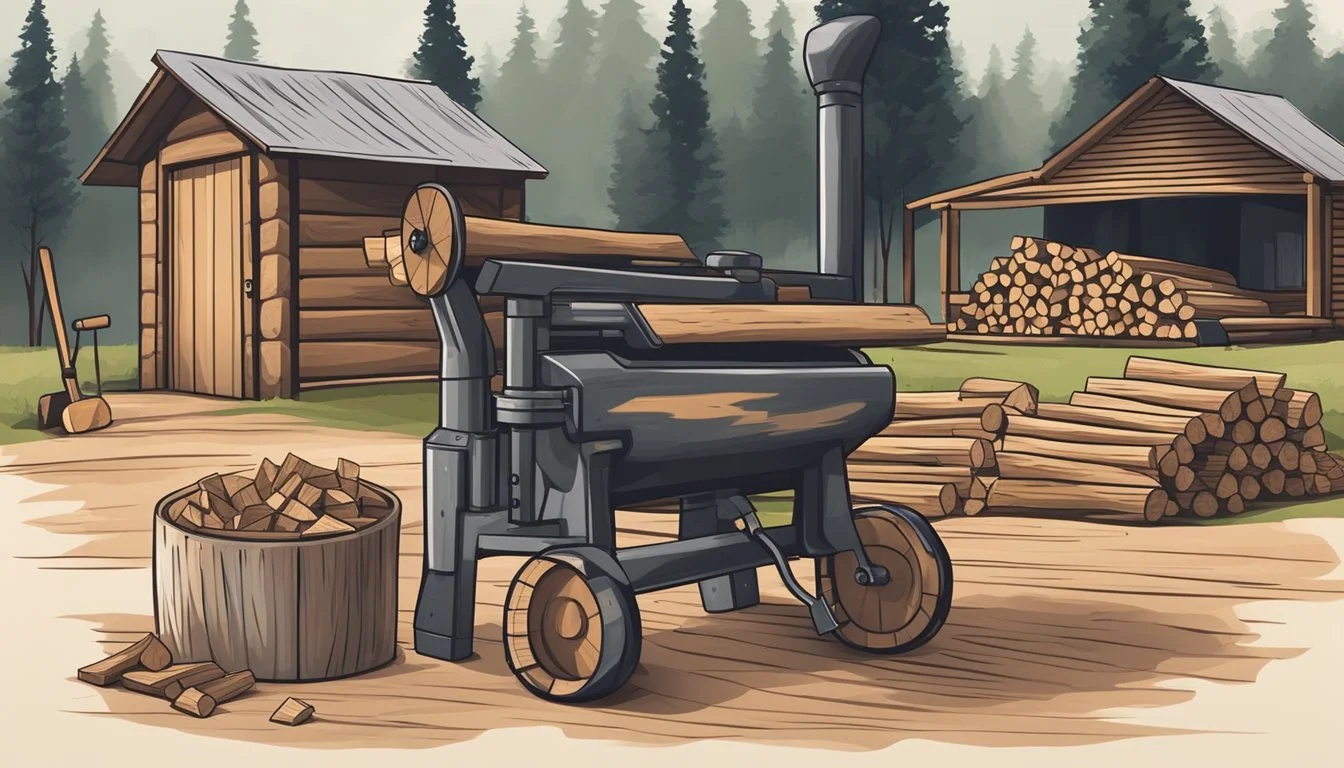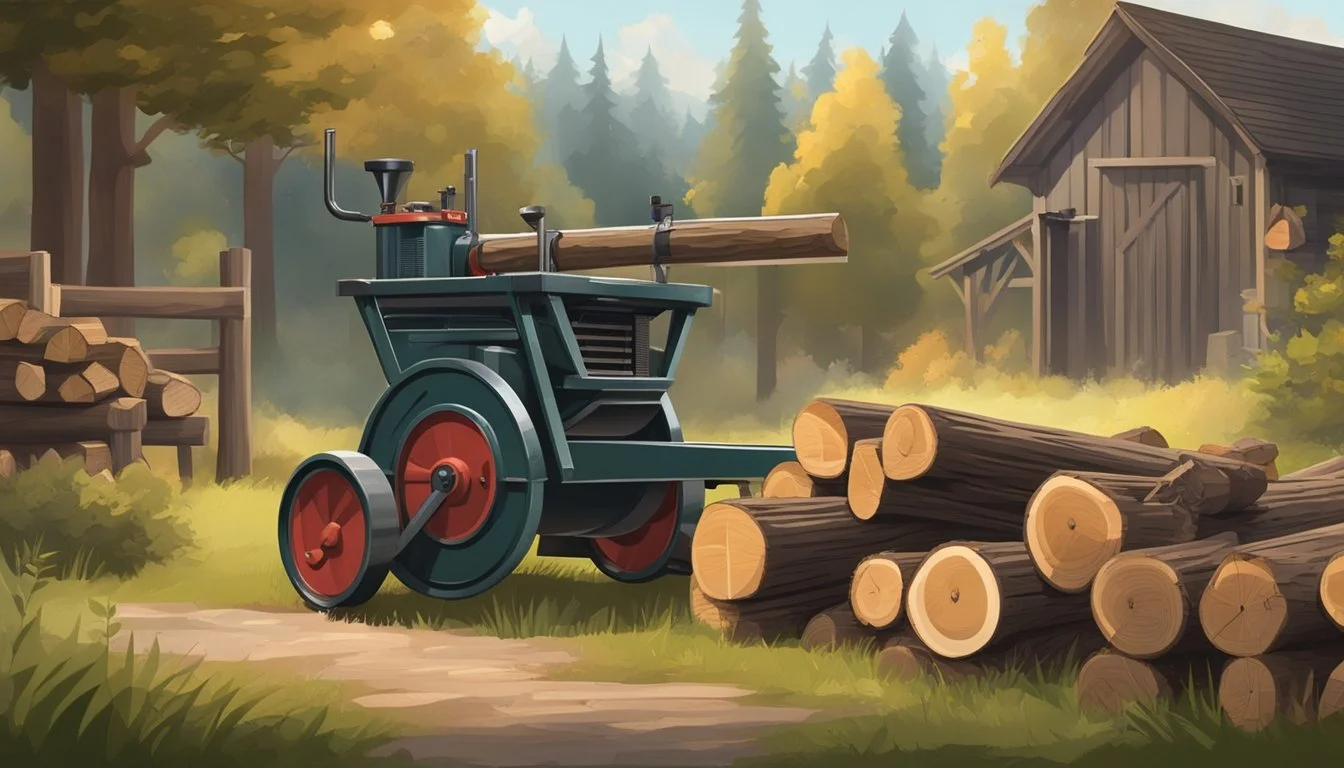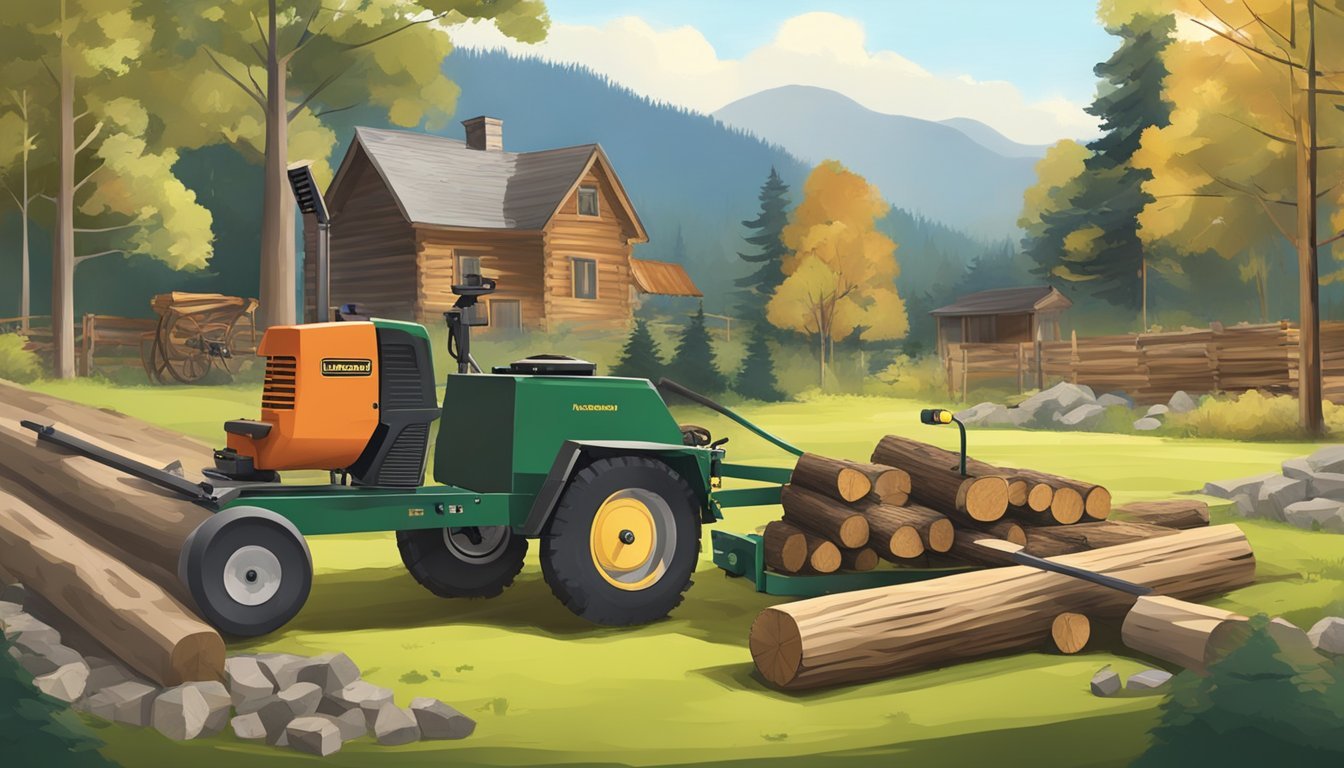Top Tips for Choosing the Best Log Splitter for Homestead Firewood Needs
A Buyer's Guide
Selecting the right log splitter for homestead firewood needs is a critical decision for efficiency and safety. For those who rely on firewood as a primary or secondary source of heating, a log splitter can save countless hours that would otherwise be spent manually splitting logs with an axe or maul. Considerations such as the size and type of wood to be split, the frequency of use, and storage capabilities play crucial roles in determining the ideal log splitter.
Electric log splitters offer a balance of power and convenience, suitable for homeowners who split mid-sized logs and seek a quieter, more environmentally-friendly option. They typically offer between 6 and 10 tons of splitting force, adequate for logs up to around 12 inches in diameter. For larger, more challenging logs, gas-powered splitters bring enhanced power, portability, and the ability to handle heavier workloads, albeit with increased noise and maintenance.
The choice between manual and hydraulic splitters is also significant. Those prioritizing cost-effectiveness and light-duty work might lean towards manual splitters for their simplicity and ease of use. Meanwhile, consumers with more substantial splitting needs might favor hydraulic models for their increased power and efficiency, capable of handling larger logs and offering a more fatigue-free operation. In either case, ensuring the log splitter has a robust construction and reliable safety features is non-negotiable for enduring performance and user protection.
Understanding Log Splitters
Selecting the right log splitter involves understanding the various types, power sources, and mechanisms they use. This knowledge ensures efficient and effective wood splitting for firewood needs.
Types of Log Splitters
Log splitters generally fall into three primary categories: manual, electric, and gas-powered. Each type is designed to fit different user needs and log sizes.
Manual Log Splitters: Ideal for smaller tasks, these splitters require human effort to operate and are typically more portable and affordable.
Electric Log Splitters: Electric models offer a balance between power and ease of use, suitable for medium-sized logs. They operate quietly and require an electrical source for power.
Gas-Powered Log Splitters: These splitters are the most powerful, capable of handling large and tough logs. They are preferred for heavy-duty work but are noisier and emit exhaust fumes.
Log Splitter Power Sources
The power source of a log splitter greatly influences its performance and suitability for specific tasks. It's important to consider the availability of the power source when choosing a log splitter.
Electric Power Source: Requires access to electricity, usually offering between 6 to 10 tons of splitting force. Good for residential use where power is readily available.
Gas Power Source: Provides higher force, up to 27 tons or more, enabling the splitting of larger and harder wood. Best for areas without access to electricity.
Manual vs. Hydraulic Log Splitters
The mechanism by which a log splitter operates is another critical aspect to consider.
Manual Splitters: Use mechanical leverage or screw mechanisms. They are labor-intensive but cost-effective.
Hydraulic Splitters: Utilize a hydraulic system to push a log against a blade or wedge, requiring less physical effort. They can be either electric or gas-powered and vary in force, with some models capable of applying over 25 tons of pressure.
Evaluating Log Splitting Needs
When selecting a log splitter, it's crucial to consider both the tonnage required and the characteristics of the logs to be split. These factors determine the efficiency and effectiveness of the splitting process.
Determining the Appropriate Tonnage
Tonnage reflects the splitter's power and is a key metric to consider. Log splitters can range from smaller units with around 6-10 tons of force, suitable for logs up to 12 inches in diameter, to powerful machines offering 27 tons or more for splitting larger and heavier logs. For typical homestead firewood needs, one should focus on the splitter's tonnage relative to the most common log size they expect to process.
Assessing Log Size and Hardness
The size and hardness of the logs are decisive in selecting a log splitter. Logs over 12 inches in diameter and heavier than 100 pounds require a more robust machine:
Electric log splitters are generally sufficient for logs up to 12 inches in diameter.
For larger logs, a gas-powered splitter with higher tonnage, possibly around 27 tons, would be more appropriate.
In addition to diameter, wood with twisted grain patterns, knots, or Y-shaped forks presents a greater challenge and may necessitate a more powerful splitter.
Features and Specifications to Consider
When selecting a log splitter, it's essential to evaluate performance capabilities such as cycle time and splitting force alongside practical considerations like portability and ease of maintenance. These features will significantly influence both the efficiency and longevity of the log splitter.
Cycle Time and Splitting Force
The cycle time, typically measured in seconds, is the time it takes for the splitter to complete a full cycle of splitting a log and returning to its starting position. Shorter cycle times mean faster wood processing. Splitting force, indicated in tons, refers to the power the log splitter exerts to split the wood. Greater force enables splitting larger and harder logs. A splitter offering a balance between a quick cycle time and a high splitting force will ensure productive firewood processing.
Average Cycle Time: 10-20 seconds
Typical Splitting Force: 6-30 tons
Portability and Storage
For users who need to move their log splitters between locations, portability is critical. Features such as wheels and handles facilitate easier mobility. The overall size and design will affect storage options, with compact models offering easier storage solutions.
Portability Features: wheels, towable designs
Storage Considerations: foldable or removable handles, vertical storage option
Durability and Maintenance
A log splitter's durability hinges on its construction materials, such as steel components that withstand repetitive use and exposure to the elements. Proper maintenance ensures longevity and consistent performance, so easy access to replaceable parts like hydraulic fluids and filters is vital.
Construction Materials: steel frames, cast iron wedges
Maintenance Needs: regular oil changes, hydraulic system checks, sharpening of splitting wedges
Each feature and specification contributes to the overall functionality and user experience of a log splitter; careful consideration will aid in choosing the best model for homestead firewood needs.
Comparing Log Splitter Models
When selecting the best log splitter for homestead firewood needs, homeowners should consider various models based on their power source—gas, electric, or manual—and their ability to handle the required log sizes and weights. Each type offers distinct advantages, depending on the specific requirements of the user.
Best Log Splitter Picks for Homeowners
For those requiring a high-performance, versatile tool, gas log splitters like the NorthStar Horizontal/Vertical 30 Ton Log Splitter provide significant power and the flexibility to tackle heavy, dense logs. Such models are often preferred for their speed and efficacy.
Electric log splitters offer a balance between efficiency and convenience, ideal for residential areas where noise levels are a concern. The WEN 56208 6.5-Ton Electric Log Splitter stands out for its ample driving force to split logs up to 12 inches in diameter, while being quieter and emitting no fumes.
Top Rated Electric Log Splitters
Electric models, known for their ease of use and maintenance, do not require fuel and are environmentally friendly due to the absence of emissions. Two highly rated electric log splitters include:
WEN 56208 6.5-Ton Electric Log Splitter
Weight Capacity: Can handle logs up to 100 pounds
Log Diameter: Up to 12 inches
Boss Industrial ES7T20 Electric Log Splitter, 7-Ton
Ease of Use: One-handed operation
Durability: Solid construction for frequent use
Choosing Gas-Powered Log Splitters
For those with larger plots of land or heavier-duty splitting needs, gas-powered log splitters are more suited due to their higher tonnage and mobility. The Southland 25 Ton Gas Powered Log Splitter has garnered attention for its robust 25-ton force capability, making it a strong contender for extensive firewood splitting tasks.
Manual log splitters, such as the Sun Joe LJ10M 10-Ton Hydraulic Log Splitter, offer a cost-effective and environmentally friendly option. While requiring more physical effort, they provide sufficient force to split sizable logs without the need for fuel or electricity.
Safety and Operation
When it comes to operating a log splitter, safety is paramount and a clear understanding of operational procedures ensures efficiency. One must always prioritize personal protection and follow the recommended use guidelines to prevent accidents.
Best Safety Practices
Safety begins with the proper attire. Operators should wear safety goggles to protect their eyes from potential flying debris, and sturdy gloves to safeguard against splinters and cuts. It is advised to avoid loose clothing that could become entangled in the machine's moving parts.
Protective Equipment:
Safety goggles
Heavy-duty gloves
Ear protection (if operating a loud splitter)
Clothing Guidelines:
Fitted clothes
Long sleeves and pants
Steel-toed boots
By adhering to these safety tips, individuals reduce the risk of injury and ensure a safer firewood splitting experience.
Operational Tips
For smooth operation, one should familiarize themselves with the log splitter's manual, understanding its specific functions and limitations. Before starting their work, they must inspect the splitter for any signs of wear or damage and ensure all safety guards are in place and functional.
Pre-Use Inspection:
Check for defects or damage
Ensure safety features are engaged
Usage Guidelines:
Operate on stable, level ground
Keep hands clear of moving parts
Do not attempt to split logs larger than the machine's capacity
Following these precise operational tips, users will achieve better performance from their log splitters and maintain a safe environment.
Additional Accessories and Tools
In addition to the main log splitter unit, homeowners should consider several essential tools and accessories that enhance efficiency, safety, and performance in the firewood splitting process.
Kindling Cracker and Splitting Wedges
For those looking to make perfect kindling, the Kindling Cracker Firewood Splitter is a valuable tool. It allows users to safely and easily create small fire-starting pieces by hammering logs through a ringed blade safely mounted to a stable platform. Splitting wedges, such as the Estwing Sure Split Wedge, are designed to make quick work of tough logs. The wedge's unique design features a fast taper head for easy starting and a sure split fins to assist with efficient wood splitting.
Kindling Cracker Firewood Splitter: Efficiently creates kindling without blade exposure
Estwing Sure Split Wedge: Features a special offset head to effectively split wood
Personal Protective Equipment
When operating a log splitter or using splitting tools, personal protective equipment (PPE) is critical for the user's safety. Durable gloves and protective goggles are strongly recommended to protect the hands from splinters and the eyes from flying debris.
Gloves: Should be sturdy and provide a good grip
Goggles: Must shield the eyes properly and resist impact
By incorporating these accessories and PPE, individuals can enhance their wood splitting experience in terms of both productivity and safety.
Maintenance and Care
Proper maintenance and care are pivotal to ensure the longevity and optimal performance of a log splitter. Adherence to these practices will prevent malfunction and preserve the unit's condition.
Routine Cleaning and Inspection
Cleaning: After each use, it's essential to wipe down the log splitter, especially its moving parts. Accumulated debris and sap can hinder the machine’s function. They should routinely check for:
Sap and wood residue on the splitter's wedge and rack.
Dust and dirt on the engine or motor housing, if applicable.
Inspection: A thorough visual inspection can catch issues before they escalate. Individuals should look for:
Signs of wear such as hydraulic fluid leaks.
Loose bolts or damaged parts that may require tightening or replacement.
Long-Term Storage Solutions
For those who won't use their log splitter for extended periods, proper storage is crucial to prevent damage from environmental factors.
Indoor Storage: Store the splitter in a dry, covered area to protect it from moisture and temperature extremes.
Fuel Treatment: If the log splitter is gas-powered, it's advised to empty the fuel tank or add a fuel stabilizer to prevent the gasoline from degrading.
Hydraulic System Care: Ensure the hydraulic fluid is at the recommended level and the system is purged of air to maintain its efficiency for future use.







